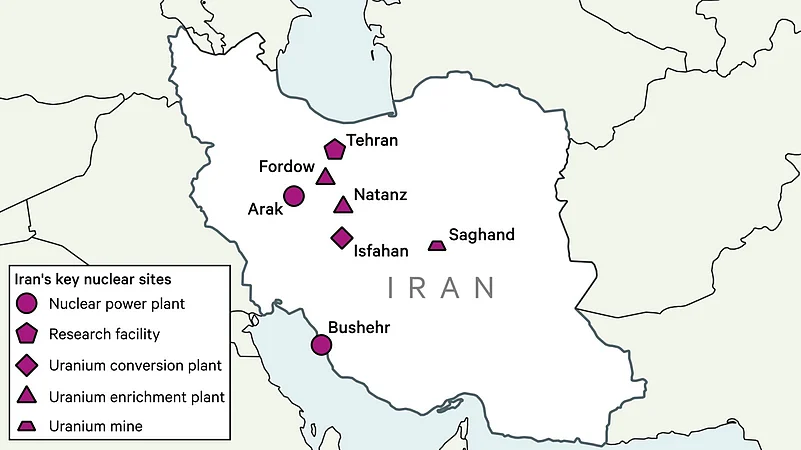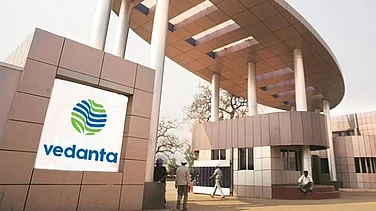The United States has struck three major nuclear sites in Iran, former President Donald Trump announced on Saturday evening amid the ongoing conflict between Israel and Iran. Trump said that US forces hit facilities in Fordow, Isfahan, and Natanz and “completely and totally obliterated” them.
Iran’s foreign minister warned that the US action would have “everlasting consequences,” while Trump cautioned that any retaliation from Iran would be met with overwhelming force.
"The events this morning are outrageous and will have everlasting consequences. Each and every member of the UN must be alarmed over this extremely dangerous, lawless, and criminal behaviour," Foreign Minister Seyed Abbas Araghchi wrote in a post on X. He added that the US had "committed a grave violation" of the UN Charter.
Iranian state media cited the country’s National Nuclear Safety System Centre, saying that radiation detectors had recorded no release of radioactive material following the US strikes.
“There is no danger to residents living near the affected sites,” the statement added.
Earlier, the International Atomic Energy Agency (IAEA) also noted that previous Israeli airstrikes on nuclear facilities had similarly resulted in no detected release of radioactive material into the surrounding environment.
However, the attacks have raised questions over the extent of Iran's nuclear development programme and how far it is willing to go. According to the 2023 report by the non-profit Nuclear Threat Initiative, Iran ranks 21st globally in protecting nuclear materials from theft, with a low score of 29 out of 100—down three points since 2020. The country’s performance has deteriorated in key areas such as the management of nuclear material quantities, site transport, and production trends. While Iran has made progress in implementing UN Security Council Resolution 1540, it lacks core nuclear security infrastructure, including independent regulatory oversight, updated legislation, and effective control and accounting procedures.
In terms of sabotage protection, Iran ranks 46th with a score of 23 out of 100. It has 80 nuclear sites identified in this category but scores poorly in areas such as physical protection, insider threat prevention, and cybersecurity—all of which remain critical vulnerabilities.
The report states that in 2021, Iran became the first country in nearly two decades to produce highly enriched uranium (HEU). By February 2023, it had amassed 87.5 kilograms of 60% enriched uranium—enough material for three nuclear weapons.
A later IAEA report in May 2025 noted that Iran’s enriched uranium stockpile had reached 9,247.6 kilograms—over 45 times the JCPOA limit—including 400 kg enriched to 60%, close to weapons-grade. Experts warn this could be enough for up to 10 nuclear bombs if further refined.
The report also noted that Iran is operating three major enrichment facilities: the Fuel Enrichment Plant (FEP) in Fordow—buried deep under a mountain near the village of Fordow, about 30 km north of Qom—and the Fuel Enrichment Plant (FEP) and Pilot Fuel Enrichment Plant (PFEP) in Natanz, south of Qom. Both Natanz and Fordow were struck by the US Army on 22 June.
According to the IAEA, these plants use various types of centrifuges, including IR-1, IR-2m, IR-4, and IR-6, to enrich uranium. Iran has also been developing fuel for the Tehran Research Reactor and the upcoming Khondab Heavy Water Reactor (KHRR), which is expected to begin operations in 2026.
Three Facilities That Were Struck
Natanz
Located roughly 250 kilometres south of Tehran, Natanz is Iran’s primary uranium enrichment complex. It plays a key role in developing and assembling centrifuges used to convert uranium into nuclear fuel—a critical step in the nuclear fuel cycle.
The site features several buildings above ground and three underground structures, two of which are reportedly capable of housing up to 50,000 centrifuges, according to the Nuclear Threat Initiative.
The Natanz Pilot Fuel Enrichment Plant, operational since 2003, was among the targets in a recent Israeli airstrike. Satellite imagery confirmed significant damage to above-ground facilities. According to the IAEA, Iran had been enriching uranium here to 60% purity—just below the 90% needed for weapons-grade material.
Reports say earlier attacks at Natanz disrupted power to the lower underground areas where centrifuges are kept. Disabling electricity to those depths is seen as one of the most effective ways to hinder the facility’s operations, given its fortified underground setup.
Fordow
Fordow is a highly secured and secretive enrichment site built deep within a mountain near the city of Qom. Much of what is known about it comes from Iranian records obtained by Israeli intelligence. The exact start date of construction at the Fordow facility is unclear. However, satellite images show signs of activity as early as 2004, including two distinct white square structures at tunnel entrances. The IAEA suggests construction may have begun as early as 2002.
The site’s main halls are buried 80 to 90 metres underground, making them extremely resistant to aerial bombardment. While the US possesses weapons capable of reaching such depths, analysts caution even those may not be fully effective.
The Institute for Science and International Security estimates that Iran could convert its current stock of 60% enriched uranium into enough material for nine nuclear weapons within three weeks if done at Fordow. The IAEA recently reported that enrichment activity at Fordow has intensified, with approximately 2,700 centrifuges now installed.
Isfahan
Situated in central Iran, Isfahan hosts the country’s largest nuclear research facility. The complex was established with Chinese assistance and began operations in 1984, according to NTI.
Isfahan is believed to be a central hub for Iran’s nuclear development. The site employs around 3,000 scientists and includes multiple components: three small Chinese-designed research reactors, a uranium conversion facility, a fuel fabrication plant, a zirconium cladding unit, and various laboratories. These elements support Iran’s broader ambitions in nuclear fuel processing and reactor development.
In addition to these facilities, Israel has targeted several other Iranian sites in the last two weeks. Among them is the Arak heavy-water reactor, located near Khondab. It was originally designed to produce plutonium, raising concerns over its potential use in nuclear weapons development. Although work was paused under the JCPOA, Iran resumed activity after Trump’s withdrawal from the deal in 2021 and informed the IAEA it plans to commission the reactor by 2026, along with a heavy water production facility.
In Tehran, the capital hosts the Tehran Nuclear Research Centre, which includes a reactor supplied by the US in 1967. While it is mainly used to produce medical isotopes, its sensitive nature and location continue to draw international attention.
Iran’s only operational commercial nuclear power plant is in the southern port city of Bushehr. Built with Russian support, the plant was connected to the national grid in 2012 and continues to receive fuel shipments from Moscow. It is monitored by the IAEA and is viewed as less controversial compared to Iran’s enrichment sites.
In late 2022, construction began on a 300-megawatt plant in Darkhovin, and groundwork has started in Sirik for a major complex of four nuclear reactors with a combined planned capacity of 5,000 megawatts near the Strait of Hormuz.


































